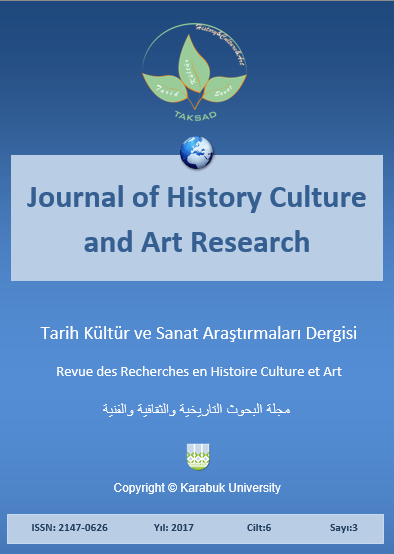Motivational Projections of Russian Spontaneous Speech
DOI:
https://doi.org/10.7596/taksad.v6i3.1022Anahtar Kelimeler:
Spoken language- oral communication- semantics- contextual meanings- pragmatics- connotation- nomination- derivation- language personality- creativity- cultural knowledge- linguistic taste.Özet
The article deals with the semantic, pragmatic and structural features of words, phrases, dialogues motivation, in the contemporary Russian popular speech. These structural features are characterized by originality and unconventional use. Language material is the result of authors` direct observation of spontaneous verbal communication between people of different social and age groups. The words and remarks were analyzed in compliance with the communication system of national Russian language and cultural background of popular speech. Studies have discovered that in spoken discourse there are some other ways to increase the expression statement. It is important to note that spontaneous speech identifies lacunae in the nominative language and its vocabulary system. It is proved, prefixation is also effective and regular way of the same action presenting. The most typical forms, ways and means to update language resources as a result of the linguistic creativity of native speakers were identified.
Referanslar
Clark, H. H., & Wasow, Th., (1998). Repeating Words in Spontaneous Speech. Volume 37, Issue 3: 201-242.
De Cock, S., (1998). A Recurrent Word Combination Approach to the Study of Formulae in the Speech of Native and Non-Native Speakers of English Source. International Journal of Corpus Linguistics, 3: 59-80.
Harchenko, V. K., (2016). Antologiya razgovornoj rechi. Nekotorye aspekty teorii. Moskva: Menand. T.1. Agrammatizmy – kreaciya, pp.: 224. T.2. Litota – percepciya, p. 232. T.3. Povtor – slovotvorchestvo, p. 216. T. 4. Somatizmy – yumor, p. 216. T.5. Monologi, p. 184. (In Russian).
Krongauz, M. (2009). Russkij yazyk na grani nervnogo sryva. Moskva: Znak, p. 480. (In Russian).
Nagorny, I. A., (2015). Aktualizacionaya functia modalnih edinic v viskazivanii. Nauchnie Vedomisti Belgorodskogo gosudarstvennogo universuteta, No. 6 (203). Vip. 30: 13-20. (In Russian).
Ogneva, E. A., Danilenko, I. A., Kireeva, Y. I., & Kutsenko, A. A., (2015). Interpretative Model of Linguacultural Knowledge. The Social Sciences, 10: 1101-1106.
Potebnya, A. A., (2007). Mysl i yazyk. Moskva: Labirint, p. 265. (In Russian).
Potebnya, A. A., (2007). Mysl i yazyk. Moskva: Labirint, p. 265. (In Russian).
Rabiner, L. R., & Juang, B. H., (1993). Fundamentals of speech recognition.
Rey, A., (1995). The Concept of Neologism and the Evaluation of Terminologies in Individual Languages Text. John Benjamins Press, p. 124.
Vinogradov, V. V., (1995). Slovo i znachenie kak predmet istoriko-leksikologicheskogo issledovaniya. Voprosy yazykoznaniya, 1: 5-37. (In Russian).
Ward, W., (1989). Understanding spontaneous speech. Mellon University. Proceedings of the workshop on Speech and Natural Language: 137-141.
İndir
Nasıl Atıf Yapılır
Sayı
Bölüm
Lisans
Tarih Kültür ve Sanat Araştırmaları Dergisi'nde yayımlanan tüm çalışmalar Creative Commons 4.0 CC-BY lisansı ile lisanslanmıştır.
Bunları yapmakta özgürsünüz:
- Bu eseri her boyut ve formatta paylaşabilir — kopyalayabilir ve çoğaltabilirsiniz.
- Materyalden Adapte et — karıştır, aktar ve eserin üzerine inşa et
- her türlü amaç için, ticari amaç da dahil
Alttaki şartlar altında:
Atıf — uygun bilgiyi, lisansa linki, and ve değişiklik yapıldıysa değişiklik bilgisinivermelisiniz. Sizi veya kullanımınızı lisansörün onayladığı bilgisini içermemek kaydıyla, size uygun şekilde bu işlemleri gerçekleştirebilirsiniz.
AynıLisanslaPaylaş — Eğer materyali karıştırdınızsa, aktardınızsa ya da materyalin üzerine çalıştınızsa, ancak aynı lisans ile dağıtabilirsiniz.
- Ek sınırlamalar yoktur — Lisansın izin verdiği hakları başkaları üzerinde kanunlarla ya da teknolojiyikullanarak sınırlayamazsınız.







